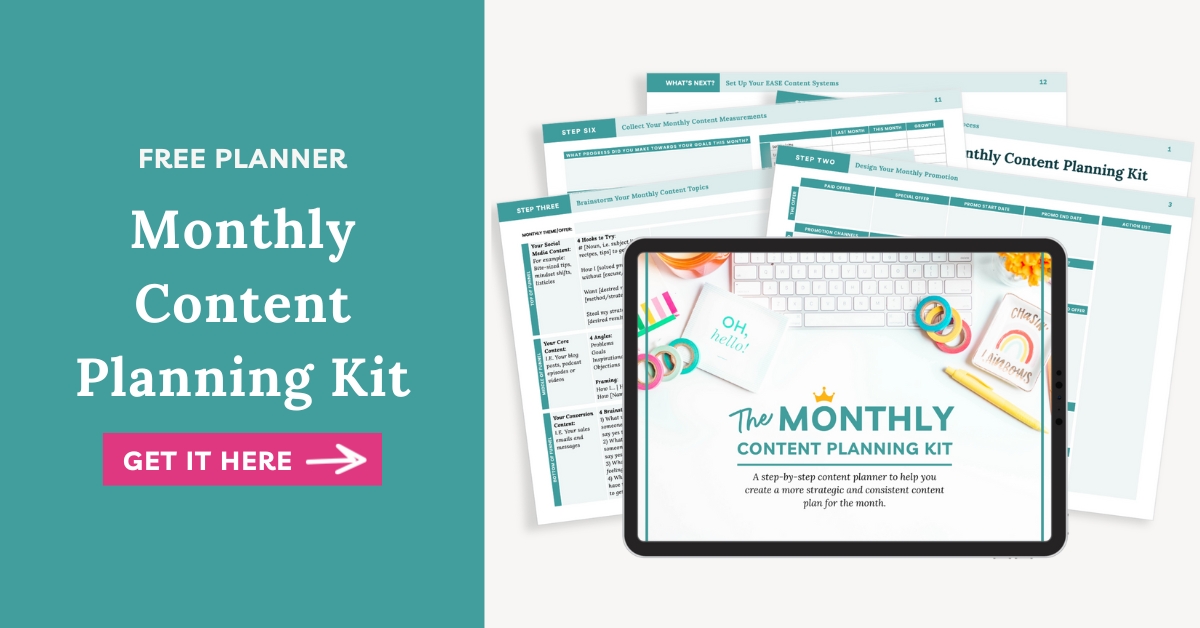This week, I've got 6 content questions I'm tackling that have been sent in from the community ⬇️
Here's a sneak peek of the content questions I'm answering:
- How do you outsource writing for a niche topic?
- How can I manage my time effectively when I can't afford an assistant? Can I handle everything on my own?
- How can I shift from seeing content creation as burdensome to finding joy in it?
- How can you repurpose old content without it seeming repetitive?
- How do you navigate the conundrum of needing an offer before creating content and vice versa?
- How much time should I allocate to content planning daily, weekly, and monthly?
Ready to Learn the Perfect Content Strategy to Grow Quickly and Start Seeing Results ASAP?
Get instant access to my E.A.S.E. Content Strategy Workshop where you'll learn the 4 content platforms and strategies to focus on to scale your results and sales from content. Plus you'll get my exclusive EASE Content Planning Spreadsheet for FREE ↓

FULL TRANSCRIPT:
Welcome back to the Content Coffee Break podcast. I'm thrilled about this week's episode. I've been searching for questions to address on the show since I'm keen on answering your major content queries. If there's something you'd like to know, don't hesitate to DM or email me. Your question might feature in an upcoming episode. By the time this episode airs, we'll be in our content empire prep school phase, organizing and setting up our content bank and measurement systems. Laying this foundation is vital for a successful content strategy and system.
Speaking of school, my puppy Moose, who's just over a year old, is in obedience school. The instructor, Linda, often emphasizes that the training is more for us, the owners, than for the dogs. She also stresses that she might offer advice we don't want to hear, but it's for our benefit. When I first heard her say that, I knew I'd borrow it for this Q&A session. I'll give it to you straight, but always in a kind way—that's just how I roll.
Over the years, I've received countless content-related questions through various channels. I've selected seven recurring ones to address today. And I'll be revisiting such questions in future episodes, so keep them coming. Here are the questions I'll be delving into:
- How do you outsource writing for a niche topic?
- How can I manage my time effectively when I can't afford an assistant? Can I handle everything on my own?
- How can I shift from seeing content creation as burdensome to finding joy in it?
- How can you repurpose old content without it seeming repetitive?
- How do you navigate the conundrum of needing an offer before creating content and vice versa?
- How much time should I allocate to content planning daily, weekly, and monthly?
Let's dive in.
Patricia Lee asked about outsourcing writing for niche topics. Great question! At my agency, we often produce content that represents the expertise of our clients. We implement a method called content interviewing. In essence, this involves questioning experts to extract their knowledge and present it in their voice. It's their expertise, after all. We capture their tone, phrasing, and unique voice through this method. If you're looking to outsource niche content, consider this approach. The key is capturing that raw material. Leveraging tools like Chat GPT for tasks such as podcast transcript clean-up can also be handy.
Jennifer Bly's question centered around time management. I'd recommend determining your Minimum Viable Output (MVO). This is the least amount of content you're comfortable producing at a given frequency. Systems and automations can then help streamline the process. Batching and theming days can also be advantageous. For instance, dedicate specific days to outlining, writing, and promotional tasks. Creating routines, like my morning writing habit, can foster consistency.
Jenny Flanagan's inquiry was about mindset. How do you transition from viewing content creation as a tedious task to a joyful activity? My recommendation: Make the creation process enjoyable for you, while ensuring the end product serves your audience. This involves identifying aspects of content creation that you genuinely enjoy. Answering actual questions from your audience can also infuse a sense of purpose and joy into the process. Consider creating an inspiration bank to keep track of queries and ideas that arise.
In summary, whether it's creating content, training puppies, or seeking clarity, always find joy in the journey and ensure that you're delivering value to your audience.
When it comes time to plan your content or create it, you can simply go to your inspiration bank, pull a question, and respond. With those two shifts, I believe you'll find more joy and opportunities to amplify that joy, helping you serve your clients, audience, or customers.
Our next question is from Corey Pollard who asks how to repurpose and refresh old content without it appearing stale. I often get this question, especially since I discuss repurposing extensively in my program, the minimalist content strategy. A reality check to remember is that people generally aren't scrutinizing your content as closely as you think. If it was engaging the first time, it's likely to remain engaging the second time. Many ask, “How often can I share the same piece of content?” Personally, I won't share something more than twice a year. I like to keep about six months between shares. Some of my clients, however, have shorter customer lifecycles, allowing them to repeat content more frequently. When creating content, always ask yourself the purpose from both your perspective and that of the audience. While some content may become outdated, I focus on evergreen educational content. When refreshing content, instead of simply adding more details, consider alternative formats. Instead of just a video, maybe create a podcast or an infographic. Approach refreshing from a perspective of format, not just adding more details.
Our next question comes from Audrey Berry. She asks about the conundrum of needing an offer to create content but requiring content to attract potential customers. This is a common challenge. One solution is to create a minimal version of the offer, allowing for testing before investing heavily in a full program. Another strategy involves content campaigns where everything published leads to an offer. Preceding a launch or preselling an offer, you could release related content to gauge interest. Quick market research, such as surveys to email lists or social media followers, can also be effective. However, it's important not to get stuck in the research phase. Controlled ad tests can be another way to assess interest in a topic.
Finally, Ana Marić asks about the time commitment for content planning. The answer is subjective, but I recommend capturing daily ideas in an inspiration bank. Weekly, organize these ideas, expand on them, and schedule upcoming content. Monthly is a good time for in-depth planning. Even if you plan quarterly, finalize details monthly. Additionally, quarterly planning for launches and promotions provides a broader view of content flow.
That wraps up our Q&A session! I've enjoyed this, and if you have further questions or want to discuss any of these topics, reach out via DM. Until next time, have a great week!
Ready to Implement?
Get instant access to my E.A.S.E. Content Strategy Workshop plus get my exclusive EASE Content Planning Spreadsheet for FREE ↓









